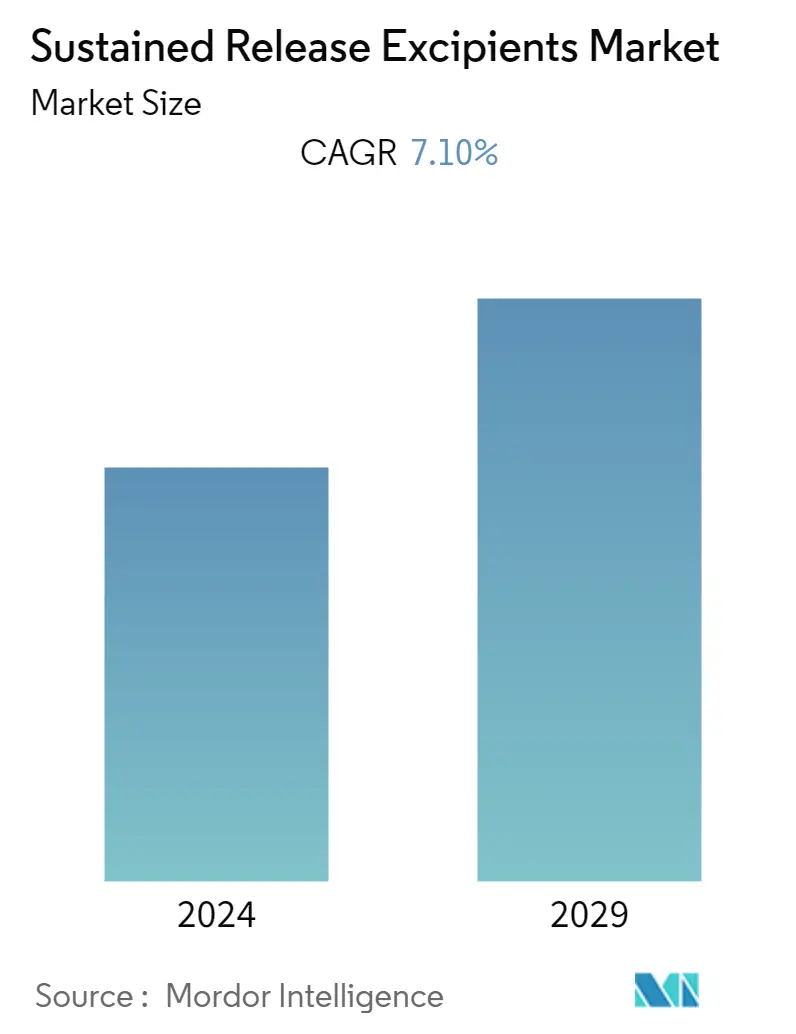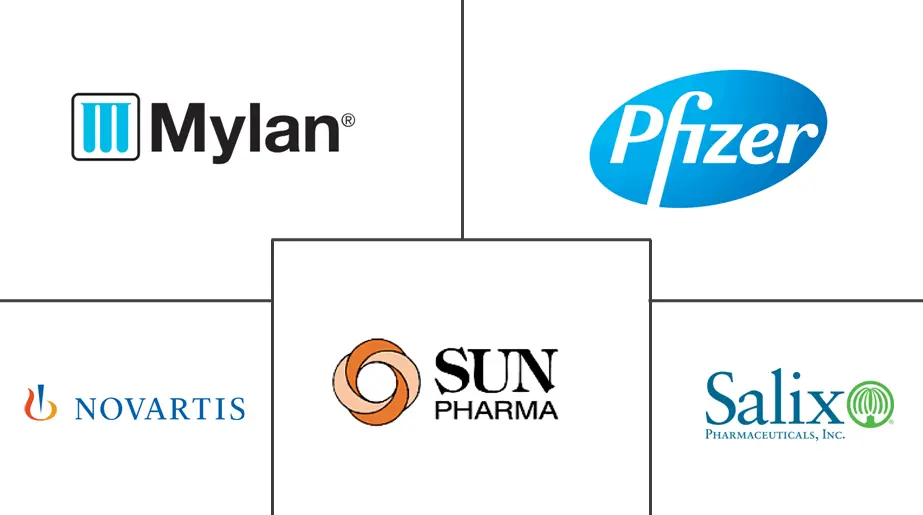Market Size of Sustained Release Excipients Industry

| Study Period | 2019 - 2029 |
| Base Year For Estimation | 2023 |
| CAGR | 7.10 % |
| Fastest Growing Market | Asia-Pacific |
| Largest Market | North America |
| Market Concentration | Low |
Major Players
*Disclaimer: Major Players sorted in no particular order |
Sustained Release Excipients Market Analysis
The sustained release excipients market is anticipated to register a CAGR of 7.1% during the forecast period.
The COVID-19 pandemic had an adverse effect on the market. Potential shortages as a result of export bans from India and China, the major suppliers of API and generics, have prompted governments in many countries to consider supply chain self-sufficiency and issue regulations to prevent shortages in such a crisis. In this regard, the European Commission published a new guideline on foreign direct investment and the free movement of capital from third-world countries in March 2020, stating that foreign investments in the European Union (EU), particularly those affecting the health market, must be subjected to risk assessments to avoid any negative impact on the European Union's capacity to meet the health demands of its citizens. The uncertainty that surrounded COVID-19 highlighted the challenges of maintaining a global drug supply chain. With the reopening of the markets globally, the market studied is gaining traction again.
The market is growing due to the initiatives such as product launches by key market players. For instance, in March 2022, Athena Bioscience LLC launched Nexiclon XR, the only once-daily clonidine extended-release tablet indicated for the treatment of hypertension. Athena acquired exclusive rights to commercialize the product from Tris Pharma Inc. in February 2021. Similarly, in July 2022, Dr. Reddy's Laboratories Ltd launched Dr. Reddy's Fesoterodine Fumarate Extended-Release Tablets, a generic therapeutic equivalent to Toviaz (fesoterodine fumarate) in the US market following the approval by the USFDA. These initiatives are expected to increase the growth of the market during the forecast period.
Factors for the growth of the market include the increased benefits over conventional dosage forms and antibiotic resistance. One of the major challenges for marketers of pharmaceutical products is the compliance of the patient. When a drug needs to be administered several times a day, patients' acceptance of the medication can decrease considerably, leaving the risk of poor treatment. In this case, a standard solution to increase medication acceptance is to formulate the drug in a dosage form that steadily releases the active ingredient over an extended period. Sustained-release profiles allow tailored dosing of the active ingredient over an extended period of up to 24 hours. Common ways to achieve such release rates are the use of film coating, a sustained-release matrix, or sustained-release drug-loaded granules.
Such sustained-release formulations have gained considerable traction in the pharmaceutical industry and are expected to continue to be a significant tool to improve the patient's experience with existing and new drugs. It also represents an attractive opportunity for companies and formulators to differentiate their potentially generic product from standard instant-release versions in the market.
Sustained Release Excipients Industry Segmentation
Sustained-release excipients are key ingredients in controlled-release formulations. Excipients are added to the drug along with active pharmaceutical ingredients of the medication. The pharmacologically inactive components of the medication's formulation are sustained-release excipients. This can be achieved through a variety of formulations, including liposomes and drug-polymer conjugates (an example being hydrogels).
The sustained release excipients market is segmented by product type (gelatin, polymers, minerals, sugars, and other product types), route of administration (oral, intramuscular, subcutaneous, transdermal, intravenous, and other routes of administration), technology (targeted delivery, microencapsulation, Wurster technique, and other technologies), and geography (North America, Europe, Asia-Pacific, Middle East and Africa, and South America). The report also covers the estimated market sizes and trends for 17 countries across the major regions globally. The report offers values in USD million for all the above segments.
| By Product Type | |
| Gelatin | |
| Polymers | |
| Minerals | |
| Sugars | |
| Other Product Types |
| By Route of Administration | |
| Oral | |
| Intramuscular | |
| Subcutaneous | |
| Transdermal | |
| Intravenous | |
| Other Routes of Administration |
| By Technology | |
| Targeted Delivery | |
| Microencapsulation | |
| Wurster Technique | |
| Other Technologies |
| By Geography | ||||||||
| ||||||||
| ||||||||
| ||||||||
| ||||||||
|
Sustained Release Excipients Market Size Summary
The sustained release excipients market is poised for significant growth, driven by the increasing demand for advanced drug delivery systems that enhance patient compliance and therapeutic outcomes. The market is recovering from the disruptions caused by the COVID-19 pandemic, which highlighted vulnerabilities in the global supply chain, particularly due to reliance on major suppliers like India and China. This has led to regulatory changes aimed at ensuring supply chain resilience, especially in the health sector. The market is witnessing a resurgence as key players introduce innovative products, such as extended-release formulations, which offer benefits over conventional dosage forms by providing prolonged therapeutic effects and improving patient adherence. These developments are supported by strategic collaborations and product launches, which are expected to propel the market forward during the forecast period.
North America is anticipated to dominate the sustained release excipients market, with the United States leading due to its robust pharmaceutical industry and the adoption of novel drug delivery technologies. The rising prevalence of chronic diseases in the region is driving the demand for cost-effective and efficient drug formulations, further boosting the market. The competitive landscape is characterized by the presence of major players who are engaging in mergers, acquisitions, and collaborations to expand their market share and develop innovative products. The market's growth is also supported by the increasing production of generic medicines, which are gaining popularity due to their affordability and effectiveness. As the market evolves, it is expected to offer substantial opportunities for companies to differentiate their products and capture a larger share of the market.
Sustained Release Excipients Market Size - Table of Contents
-
1. MARKET DYNAMICS
-
1.1 Market Overview
-
1.2 Market Drivers
-
1.2.1 Increased Benefits over Conventional Dosage Forms
-
1.2.2 Antibiotic Resistance
-
-
1.3 Market Restraints
-
1.3.1 Drug Toxicity due to Dose Dumping
-
1.3.2 Need for High Dose of API
-
-
1.4 Porter's Five Force Analysis
-
1.4.1 Threat of New Entrants
-
1.4.2 Bargaining Power of Buyers/Consumers
-
1.4.3 Bargaining Power of Suppliers
-
1.4.4 Threat of Substitute Products
-
1.4.5 Intensity of Competitive Rivalry
-
-
-
2. MARKET SEGMENTATION (Market Size by Value - USD million)
-
2.1 By Product Type
-
2.1.1 Gelatin
-
2.1.2 Polymers
-
2.1.3 Minerals
-
2.1.4 Sugars
-
2.1.5 Other Product Types
-
-
2.2 By Route of Administration
-
2.2.1 Oral
-
2.2.2 Intramuscular
-
2.2.3 Subcutaneous
-
2.2.4 Transdermal
-
2.2.5 Intravenous
-
2.2.6 Other Routes of Administration
-
-
2.3 By Technology
-
2.3.1 Targeted Delivery
-
2.3.2 Microencapsulation
-
2.3.3 Wurster Technique
-
2.3.4 Other Technologies
-
-
2.4 By Geography
-
2.4.1 North America
-
2.4.1.1 United States
-
2.4.1.2 Canada
-
2.4.1.3 Mexico
-
-
2.4.2 Europe
-
2.4.2.1 Germany
-
2.4.2.2 United Kingdom
-
2.4.2.3 France
-
2.4.2.4 Italy
-
2.4.2.5 Spain
-
2.4.2.6 Rest of Europe
-
-
2.4.3 Asia-Pacific
-
2.4.3.1 China
-
2.4.3.2 Japan
-
2.4.3.3 India
-
2.4.3.4 Australia
-
2.4.3.5 South Korea
-
2.4.3.6 Rest of Asia-Pacific
-
-
2.4.4 Middle East and Africa
-
2.4.4.1 GCC
-
2.4.4.2 South Africa
-
2.4.4.3 Rest of Middle East and Africa
-
-
2.4.5 South America
-
2.4.5.1 Brazil
-
2.4.5.2 Argentina
-
2.4.5.3 Rest of South America
-
-
-
Sustained Release Excipients Market Size FAQs
What is the current Sustained Release Excipients Market size?
The Sustained Release Excipients Market is projected to register a CAGR of 7.10% during the forecast period (2024-2029)
Who are the key players in Sustained Release Excipients Market?
Mylan N.V. , Pfizer, Inc. , Sun Pharmaceutical Industries Ltd. , Salix Pharmaceuticals and Novartis AG are the major companies operating in the Sustained Release Excipients Market.

